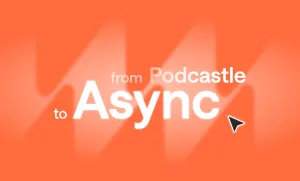Do you ever listen to the radio when you're driving? Or music on your phone while you're working out? What about talking on the phone? Chances are, you've engaged in audio marketing without even realizing it. Audio marketing is simply using sound to get your message across, and it can be a powerful tool for your business. Here's why your business needs audio marketing, and some ideas for how to get started.
What Is Audio Marketing?
Audio marketing is a form of marketing that uses sound to promote your brand. It can be used to promote your business, products, or services, and it can be a powerful tool for reaching your target audience. Audio marketing is different from other forms of marketing in that it can be very personal and interactive. It can also be a great way to connect with your target audience on a more emotional level.
Here are some audio marketing statistics:
- Ad spending in the audio advertising market worldwide is forecasted to reach US$40.64bn in 2025.
- 79% of Americans age 12+ listen to online audio monthly, an estimated 228 million people
- Number of podcast listeners worldwide reached 584.1 million in 2025, showing a 6.83% year-over-year increase. By 2027, the number of podcast listeners worldwide forecasted to hit 651.7 million.
Just like any other form of marketing, audio marketing requires a strategy. You can’t just start producing audio content and expect people to find it and listen to it. You need to have a plan for how you will produce and promote your audio content.
First, you need to determine the goal of your audio marketing campaign. Are you trying to increase brand awareness, drive website traffic, or sell products or services? Once you know what you want to achieve, you can create audio content that aligns with your goals.
Your audio content can take many different forms, such as podcasts, audio ads, voice search results, or voice-enabled advertising. Below are some tips on how to produce and promote your audio content.
- Produce high-quality audio content: This is especially important for podcasts. People are more likely to listen to a podcast if the audio quality is good. Invest in quality recording software and make sure to edit your audio clips before publishing them.
- Make your audio content relevant to your target audience: Do some research and figure out what topics your target audience is interested in. Then produce audio content that aligns with those interests.
- Use social media to promote your audio content: Share links to your audio clips on Twitter, Facebook, and other social media platforms. You can also use social media ads to promote your audio content.
- Use keywords in your audio content titles and descriptions: This will help people find your audio content when they’re searching for related topics online.
- Consider using voice search engines to reach new audiences: More and more people are using voice search engines like Google Voice Search and Amazon Echo Show to find information online. If you optimize your audio content for these platforms, you can reach new listeners who might not have otherwise discovered your content.
5 Key Benefits of Audio Marketing
1. Reach a large audience
There are more than 79% of Americans who listen to audio daily, and it's because audio is everywhere. From every device to every situation, audio content fits into people's routine. That’s what gives audio a scale most formats can’t match. If your message is distributed through podcasts, audio ads, or streaming platforms, it has a better chance of being heard repeatedly by the same person, in multiple places, throughout their week.
2. Connect with your target audience on a personal level
Audio marketing is a very personal and interactive form of marketing. Since there's no design or visual elements, you have to rely on pacing, tone, and word choice to reflect your brand in ways that feel natural. That matters when you want your audience to feel like you understand them. If you’re trying to build long-term trust, or speak in a tone that matches your product or community, audio gives you room to do that without pushing.
3. Increase brand awareness
Most people can recognize a brand by its look. Fewer can do it by sound, which makes it an opportunity for those who can. If you use the same voice, tone, and structure consistently across your audio content, people start to associate that sound with your brand. For instance intros, music beds, taglines, or just a consistent style of speaking and questioning. Over time, those small choices lead to recognition.
4. Drive website traffic
If you include links to your website in your audio content, you can drive traffic back to your site. That could be a website URL, a discount code, or a simple call to search for your brand. You can also use show notes and podcast descriptions to drop direct links. Either way, this is a great way to increase leads and conversions for your business.
5. Generate new leads and sales
Audio ads can be a great way to generate new leads and sales for your business. When people hear your audio ad and then visit your website, there’s a much higher chance that they’ll buy something from you. To boost conversions, many businesses use tools like an AI sales assistant to automate follow-ups and personalize outreach. G2 experts have put together a comprehensive guide on the best AI sales assistant software to help you choose the right solution.
Questions to ask before designing your audio marketing strategy
Here are a couple of questions you should ask yourself before starting your audio marketing strategy:
1. What is the goal of your audio marketing campaign?
Before recording a single word or selecting background music, you need clarity on what you’re trying to achieve.
– Are you trying to drive attention to a product launch?
– Build long-term brand awareness through consistent messaging?
– Capture leads with gated audio content or podcast CTAs?
– Build trust by offering behind-the-scenes insight in a human voice?
Defining your goal early on will shape everything else: the tone of voice you use, the platforms you prioritize, the scriptwriting style, and even the pacing of your edit. Without a clear objective, you risk building great audio that doesn’t actually move the needle for your business.
2. What type of audio content will you produce?
The format is crucial. If you’re hoping to build an ongoing connection with your audience, a podcast series with interviews or storytelling might be the right fit. If you’re focused on fast conversions or campaign-specific reach, short-form audio ads placed on streaming platforms or inserted into popular podcasts might get you there quicker. You could also experiment with voice search–optimized snippets, product walkthroughs, or audio landing pages that play automatically when users open your site. The key is to choose the type of content that aligns not only with your goal but also with the way your audience already consumes sound.
3. Who is your target audience?
Your audio content should speak to someone specific, not everyone in general. Is your audience made up of busy professionals who listen during their commute, or students who stream content while studying? Are they Gen Z consumers who expect casual, unfiltered language, or enterprise buyers who prefer clarity, precision, and polish? Knowing who they are down to the finest details allows you to write better scripts, select the right voices, and tailor your content for maximum impact.
4. What budget do you have for audio production and promotion?
Great audio can be made on a budget, but planning your spend upfront keeps you from getting stuck midway through the project (or worse, blowing your budget on production with nothing left for distribution). If you’re working with limited funds, focus on high-impact formats that require minimal resources, like AI voiceovers for quick ad scripts or single-voice recordings with free music beds. As your budget grows, you might bring in professional voice talent, license premium music, or invest in ad placements on larger platforms. The important thing is to know what you can afford, where you want to invest most, and what corners can be cut without compromising quality.
5. What audio marketing platforms will you use?
The platform you choose can determine who hears your message and how often they return to it. If you’re promoting audio ads, you’ll likely work with platforms like Spotify Ads Studio or programmatic audio advertising platforms that target listeners based on genre, mood, or location. If you’re building interactive experiences, voice-enabled devices like Alexa or Google Assistant would be a strong choice, along with YouTube (which, despite being a video platform, is one of the largest platforms for audio content).
How to Create Audio Content with Podcastle
Good audio comes from intention, from knowing exactly what you want your listener to hear and making every detail serve that message, whether you’re building a product teaser or shaping a voiceover to carry a campaign without relying on visuals.
While traditional editing setups can slow that process down with clunky tools and cluttered timelines, Podcastle's Audio Editor strips it back to what actually matters: a clean, flexible space where you can record, refine, and build layered audio projects with the same level of control you’d expect from a studio.
Here’s how to make it happen.
Step 1: Start a New Project and Set Up Your Tracks
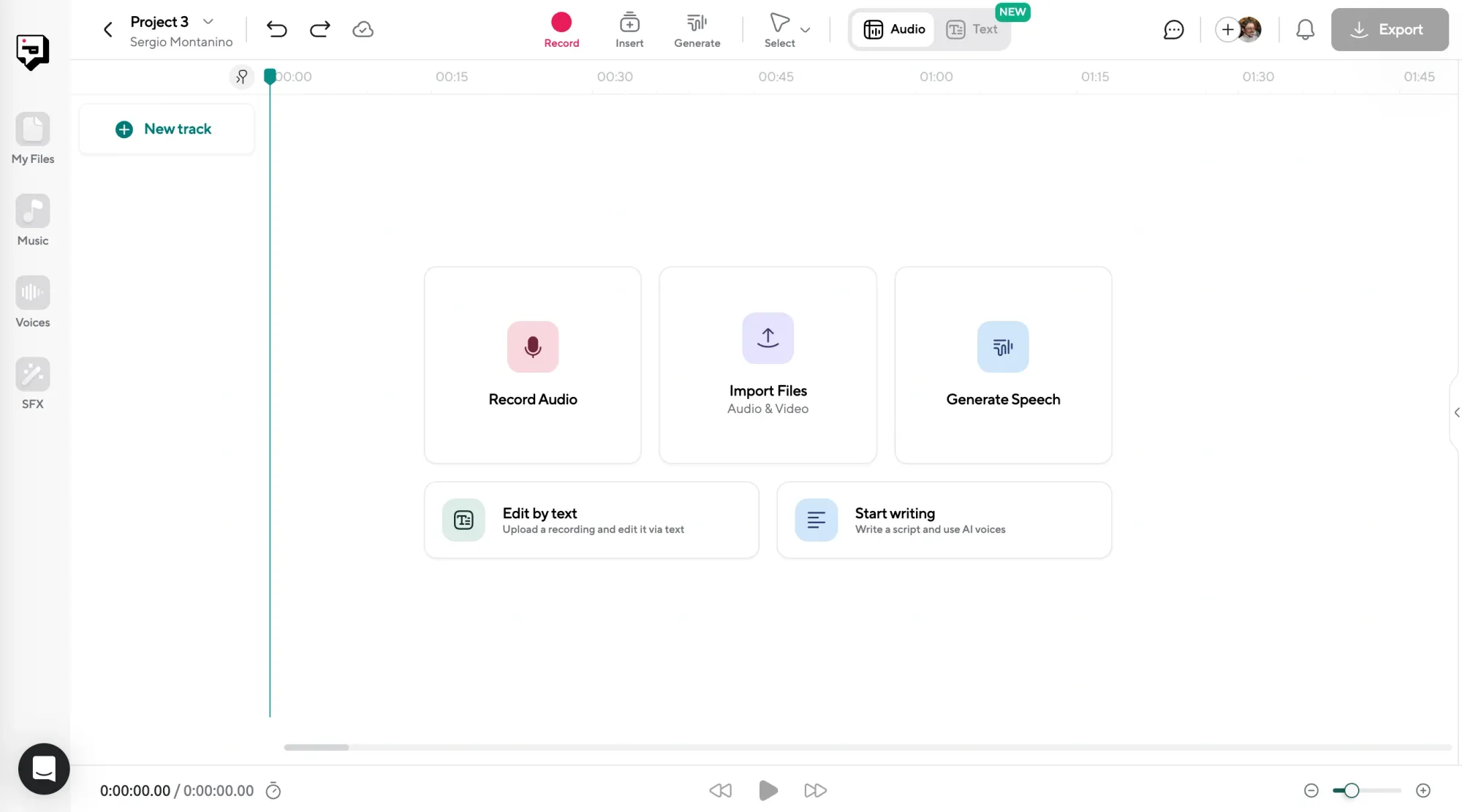
Open Podcastle and click New Project. You’ll land in the multitrack editor—this is where all your audio layers will live. Click Record to begin capturing your voice directly. You can add multiple tracks if you plan to layer music, sound effects, or extra narration later.
Step 2: Record Your Audio (or Bring in Existing Files)
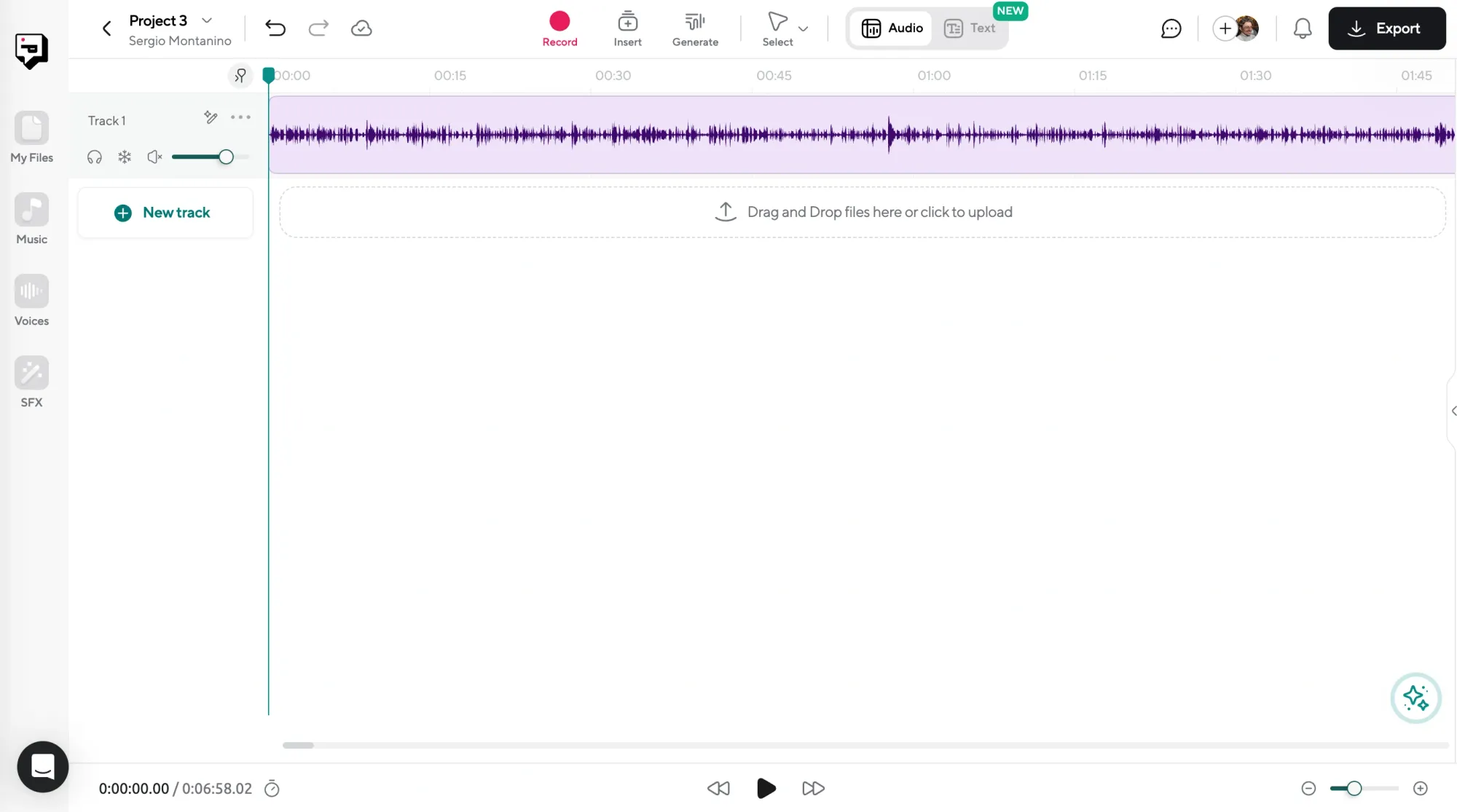
Use your microphone to record directly into Podcastle, or upload existing audio files. If you’re working with guest interviews, product voiceovers, or ad scripts, now’s the time to bring everything into the timeline. You can also use Podcastle’s AI voice feature if you need a quick voiceover and don’t want to record one yourself—but treat this as a shortcut, not the centerpiece.
Step 3: Clean Up Your Audio with AI Tools
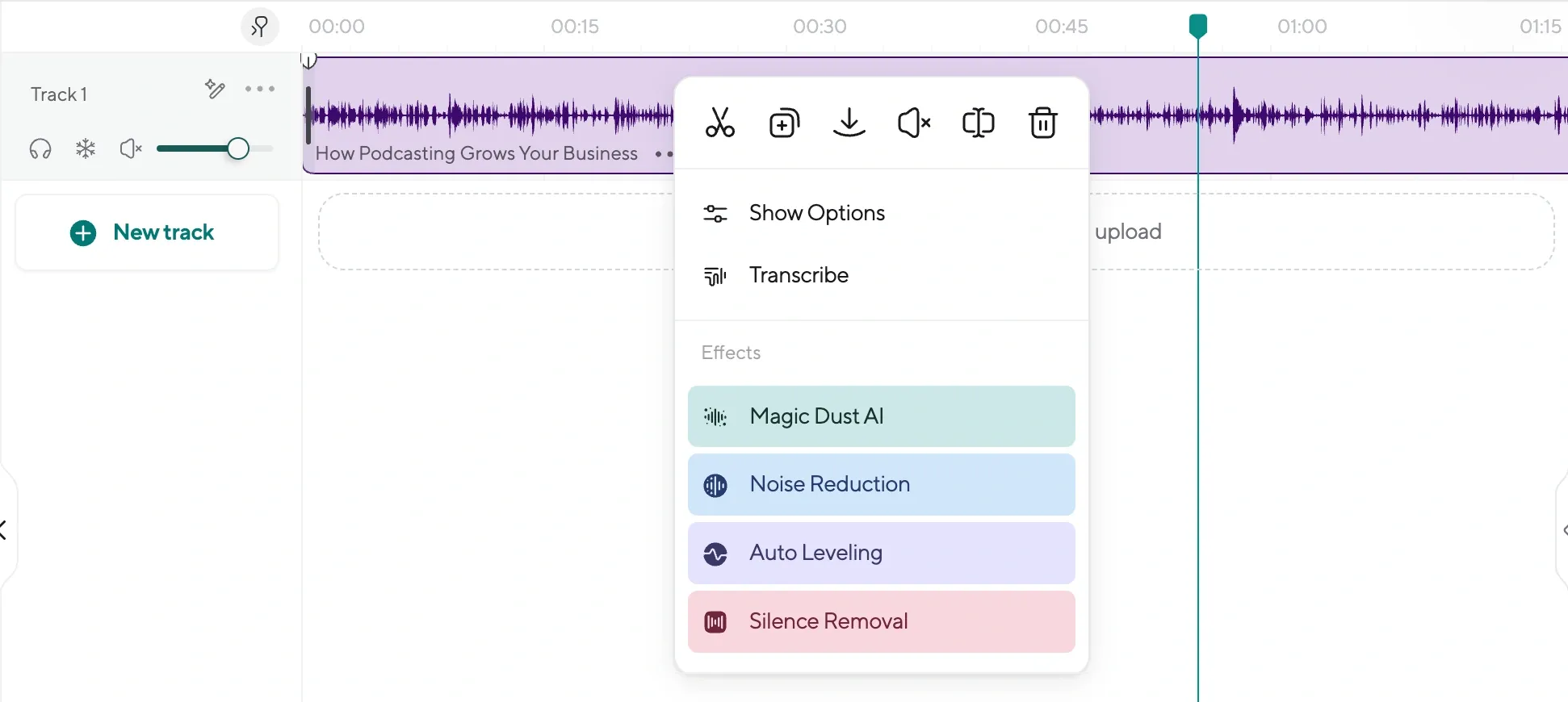
Once your voice is in, make it shine. Podcastle’s Magic Dust feature removes background noise and evens out volume with a single click. Use Silence Remover to clean up awkward gaps, or run the Filler Word Detector to quickly delete every “um” and “uh” without lifting a finger. These tools help you move fast while keeping your sound sharp.
Step 4: Layer Music and Polish
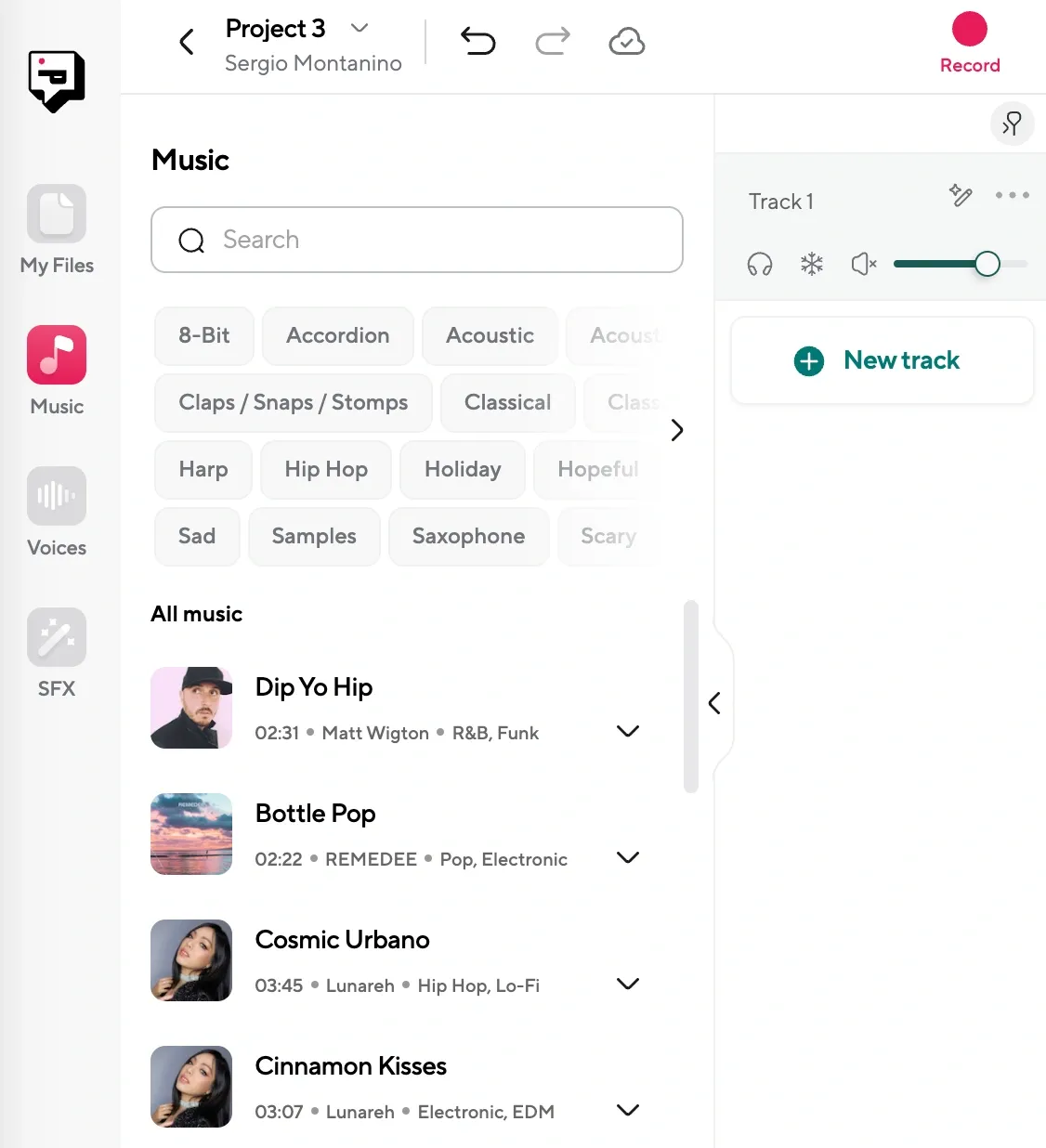
Drag royalty-free music or branded audio clips into your project. You can fade them in and out, lower background music behind voice tracks, or time it perfectly to your script. Adjust clip lengths, cut sections, and move pieces around freely—it’s all non-destructive, so you can experiment until it clicks
Step 5: Export and Distribute Your Audio Content

Once your project sounds clean, confident, and campaign-ready, hit Export. Choose your format (MP3 or WAV), and you’re good to go. From there, you can upload your voiceover to YouTube, embed it on your site, turn it into a podcast ad, or sync it with visuals in your next video edit.
The best part? You can get all of this done in your browser with instant drag-and-drop.
Final Thoughts
Audio marketing can be a great way to reach new audiences and achieve your business goals. By following the tips above, you can produce and promote high-quality audio content that will help you reach your target audience.
What are your thoughts on audio marketing? Have you used it for your business? Let us know in the comments below!







